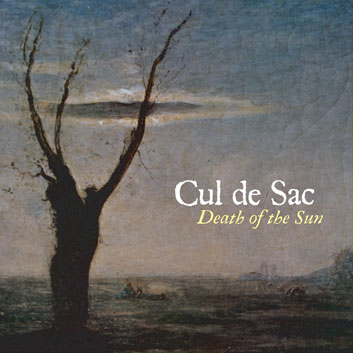. . . the critics on Cul de Sac:
"Cul de Sac's mood maestros are so innovative they're absolutely post-everything." --Scot Hacker, Utne Reader
"Cul de Sac seem to be about making post-rock for people who still like to rock, but are just sick of paint-by-numbers structures. Which is just fine by me." --Jason Ferguson, Raygun
"In the vanguard of the current crop of vocal-free indie-rock outfits. . . . Cul de Sac makes surf music with wings." --Time Out New York
"Where many groups today . . . echo Krautrock's guitar textures, Cul de Sac alone have caught the vibe, the groove of that era. . . . Fantastical, fractal sound-colours and endlessly metamorphosing shapes." --Simon Reynolds, Melody Maker
"Their sound exists at a nexus where kraut rock, American primitive guitar, Gong-style UK drug-space, Stockhausen, and the experimental wing of the avant-garage all meet w/ a splat." --Byron Coley, Forced Exposure
"Utterly unique and captivating. . . . A band producing music I really don't feel I deserve." --Ptolemaic Terrascope
"Cul de Sac offer an experimental alternative for the '90s -- it's up to you to grab that opportunity." --Nigel Cross, Hartbeat!
". . . Cul de Sac ultimately sound truly American, albeit the sound of a denuded, depopulated America, an America that decided to scrap everything and start again. This isn't 'post' or anti-rock, but a whole index of directions in which rock music could go right now." --David Stubbs, Melody Maker
"It just so happens that what Cul de Sac does is suddenly extremely fashionable on the American underground scene, but don't let that deter you from exploring the myriad delights offered by the Boston quartet. Long before the current vogue of Kraut-rock influenced 'space rock' (Sabalon Glitz, Labradford, Space Needle) and instrumental 'post rock' (Tortoise, Ui, Rome), Cul de Sac was exploring the hypno-grooved aesthetic of early '70s German bands like Can and Neu!" --Simon Reynolds, Request
"Pulsing with air-raid analog synths, sweltering art-surf guitar and aggro jazz-rock drumming, Cul de Sac seem like logical descendents of the Hawkwind-to-Can space rock lineage." --Guitar Player
"Critics have attempted to pin Kraut-rock credenitals onto nearly every rock outfit that improvises these days, but in Cul de Sac, they just about stick. . . ." --Mike Barnes, The Wire
". . . there's a group called Cul de Sac -- very ambient, very cool." --Lou Reed (Interviewed in Mojo)
"It used to be, in the early '70s, that there was an instrumental rock tradition that had nothing to do with surf music or metal wankery, dedicated to probing, exploratory semi-improvisation. Boston's Cul de Sac has almost singlehandedly revived that tradition with a series of intricate, understated singles and albums, and now that groups like Tortoise and Ui are leaping into it too, Cul de Sac's time has come." --Douglas Wolk, CMJ
"Given the sweeping open-ended nature of of the mostly instrumental,
psychedelic excursions by this Boston quartet, it's difficult to envision a
more inappropriate name than Cul de Sac." --David Sprague, Rolling Stone
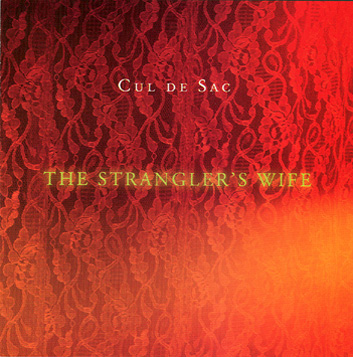 |
The Strangler's Wife (2003)
". . . one of their richest and loveliest records yet . . . a set of gorgeous textural compositions that cultivate a romantic, twilight sensibility in which fingerpicked guitars, crackling 78 rpm crooners and skittery analogue synthesizers pay homage to disparate musical elements of the departed 20th century . . . ['Dust of Butterflies'] discloses a region of time and memory in which childhood and old age, radiance and darkness are summoned in equal part . . . impeccably made music where nothing is overdone. Its keen sonic sensitivity achieves a rare grandeur." --Christoph Cox, The Wire
". . . a work of genius, innovation, vision and intelligence." --Keith Bennett, The Weekly Dig
"This uncategorizable and hallucinogenic sonic stew blends radiant feasts of samples and electronics with meandering guitar, sitar, violin, field recordings, melodica and sparse drums into one hell of a mesmerizing whole. Putting a genre tag on this is just plain stupid. . . ." Mats Gustafsson, Broken Face
". . . this long awaited . . . record from one of our favorite groups is a stylistic breakthru. . . . It's really no surprise that if any band could do this well, it would be the always-amazing Cul de Sac. This record is the hands-down best lull-you-to-sleep record of the year so far -- reminiscent of lots of AQ faves (Phillip Jeck, No Neck Blues Band, Bohren, Jackie O Motherfucker, Birchville Cat Motel Band, Third Ear Band) but totally amazing and original as always!" --Aquarius Records
". . . once Cul de Sac has worked out an idea, it rarely looks back. . . . It's refreshing to hear a band move from idea to idea so completely instead of merely looking in different directions while holding rigidly to a known foundation. The pieces all seem composed from scratch, as if each one is an entirely separate project . . . Cul de Sac has made an art of attention to detail." --Martin Pavlinic, Junkmedia
". . . Trussell's work with sampling and sequencing is his particular addition to the mix, and it can be heard in such winners as the title track, a mix of everything from heavily distorted guitar abuse to samples of sound sculptures and a throbbing core drum part. 'Dust of Butterflies' . . . demonstrates the mix and match potentials beautifully . . . the whole song has a strange, entrancing atmosphere . . . how the muffled flow of the backing textures sounds like both a loop and a looming summer shower, and how Jones' guitar provides gentle, crisp contrast even as the elegant, mournful arrangement blossoms into that of a full band. Jones himself gets a fine moment of source material glory with 'Bellevue Bridge,' drawing on field recordings done in the town where he grew up, his own shimmering electric guitar part making everything sound all the richer and more beautiful, with Jon Proudman's shift to sparkling cymbals and Trussell's toy piano the icing on the cake. Proudman gets a chance for a great drumming showcase with 'Turok, Sun of Stone' . . . a storming but never overwhelming roll of percussion propulsion, his bandmates adding low drones and restrained touches while guest singer Juliet Nelson adds wordless, echoed calls." --Ned Raggett, All Music Guide
". . . an amazing, if tranquil, record that is the result of three years of sophisticated experimentation with sampling held to a high aesthetic standard." --Outsight
"As the band's beautiful acoustic drums, bass, and acoustic guitar accompany the scratchy old piece ['I Remember Nothing More'] the listener's world just melts away into a puddle of archaic bliss. . . . Death of the Sun doesn't just see Cul De Sac at its best, it sees music at its most powerful and rewarding. Hunt this one down, you won't regret it." --Matt Shimmer, Indieville
". . . though I might question whether or not the context of Cul de Sac's music can be definitively called rock, Death of the Sun meets the band's aims with favorable results. . . . 'Dust of Butterflies' samples a 1933 78-rpm record . . . to create a dreamy, tropical undulation, nicked by electronic glitches and set afloat on LaMaster's sonorous violin. 'Bamboo Rockets' samples Peruvian field recordings, but more prominently features Jones on electric sitar, which eerily dances over the deep, dark sounds of the sampled rain forest audio and Proudman's drums. 'Turok, Son of Stone' samples and loops tribal-inspired drumming from Proudman, upon which unearthly moans and hisses flitter and decompose. 'Bellevue Bridge,' featuring recordings made on the aforementioned structure in Jones' childhood hometown in Nebraska, is Death of the Sun's only real plunge into Americana, with Jones' guitar echoing John Fahey and bluegrass fingerpicking while cars pass in the distance and the rest of the group create an expansive and dramatic backing score. . . . The main strength of the album is Amos and Trussell's ability to integrate the samples in a way that makes them sound organic and integral to the song . . . a success, and though a few tracks may linger too long, or the normally well-crafted manipulation of the samples loses its flair from time to time, Cul De Sac have managed to do better at using these samples and integrating them into their work than many, many musicians who have tried before them." --Adam Strohm, Fakejazz.com
|
|

Immortality Lessons (2002):
"Cul de Sac sparkle. . . . Modal guitar, autoharp and bouzouki dance in sweet synthesizer soup; bass and drums lock in a rolling heartbeat. There are no vocals, just like the best parts of early Pink Floyd LPs." --David Fricke, Rolling Stone
". . . comes out of nowhere like a shot in the head . . . glorious, spacious and clear . . . could be the ultimate Cul De Sac document. Its sprawling, nonstop performance segues the energetic, reverb-soaked arabesque of 'Etaoin Without Shrdlu' and the title track (originally cut with Fahey but omitted from their album collaboration), with the concrete tape manipulation of 'Liturgy' and the gentle comedown of 'Blues In E,' with Jones's guitar showering snowflake flurries of notes onto the circling depths of Michael Bloom's bass . . . the sense of boundless continental space in Cul De Sac's music is no one else's but their own." --David Keenan, The Wire
". . . might be Cul de Sac's finest recorded work. . . ." --George Parsons, Dream Magazine
". . . a fantastically fine album, readily capturing the inventive blend of styles and approaches which made the band one of America's best art-psych groups in the '90s and beyond. Perhaps above all else it's the sense of silence and careful playing that the foursome bring which is so striking here -- consider the extremely subdued but not absent drumming on Proudman's own composition here, the brief 'Enhoft Down,' or the understated drive and ghostly synth that makes up Bloom's own contribution, 'Tartarugas.' 'The Dragonfly's Bright Eye,' one of two tracks that top ten minutes (the other being the excellent zoneout 'Blues in E') is a great showcase for both how the performers work together and how they can still showcase their own abilities just so." --Ned Raggett, All Music Guide
". . . nothing short of brilliant. Somehow, in the dead silence of a university campus abandoned for summer, with a lack of sound checks, conflicts and emotions running high amongst band members, Cul de Sac managed to create not only a solid, but a stand out, performance . . . [captures] all the subtle dynamics of the band's performance, making this a must have . . . a great place to start if just discovering the band." --Jeff Fitzgerald, Aural Innovations
". . . a keeper. Apocalyptic post-rock soundscapes crash across planes of infinite space, all in an effort to produce one giant headtrip. All of the songs . . . flow into each other perfectly and beautifully . . . . Cul De Sac have scored another hit; let's just hope they never reach the end of their road." --Matt Shimmer, Indieville.com
". . . their ecstatic instrumentals will definitely appeal across lines, from space-rockers to jam-band enthusiasts. As with most of Cul de Sac's recordings, a slightly sentimental tone pervades, somewhere between forward-looking and backwards-glancing. And occasionally, that's all the uplift you need." --Christopher Dare, Pitchfork
". . . the most flowing and organic recording the band has yet made. Combining new material with old, this set has all of the band's best elements in place and rippling gently. Vaguely krauty, with hints of the Sun City Girls' Eastern smoke tendrils, candles quivering in the Canterbury night, genuine ethno-leftovers, and Fahey's evil dreams making the curtains flutter. It is really just the sort of thing that one of the band's devotees would want to play for the uninitiated. Until they unleash their recordings with Damo Suzuki (the live show I saw with them paired was truly magnificent), this will serve as the best possible documentation of their live schtick." --Byron Coley, Dream Magazine
"The liner notes here describe the awkwardness of creating a musical atmosphere in a frat-ridden student hall. Yet, somehow, Cul de Sac pull it off, recreating spacy, raga-like instrumentals like 'Flying Music from Faust' and 'Frozen in Fury on the Roof of the World' as if the group were playing their fabled 'contraptions' atop Peyote Mountain" --Chris Rolfe, Eye Weekly (Toronto)
". . . Cul de Sac don't really sound like anything else. This performance captures them alone in a room with a couple of mikes . . . raw but beautiful and strange. . . ." --Benjamin Boles, NOW (Toronto)
". . . one of Cul de Sac's finest achievements. The nine pieces gracefully flow as one creation. The drifting mood induces a relaxing tone where nuances are important . . . a fantastic excursion." --Doug Simpson, Skyscraper
"This is music that works well with mushroom tea, slow burning spliffs, candles, occasional nakedness and closed eyes . . . pleasant and hypnotic and at times, damn intriguing." --Weekly Dig (Boston)
". . . classic Cul de Sac. . . . 'Chasing Lint Particles in the Pale Moonlight' is truly epic. Here is a band who have been beavering away around the fringes of the avante garde and underground since the 70's [sic!] and are now reaping the rich harvest of their experience and love. Maybe you could do with some of it too. . . ." --Steve Hanson, Ptolemaic Terrascope
|
|
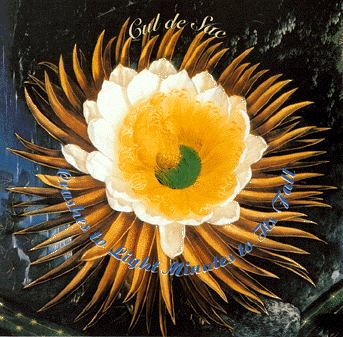
. . . Crashes to Light, Minutes
to its Fall (1999):
[4 & 1/2 of a possible five stars] "These post-rock progenitors from Boston have spent the '90s inching toward brilliance -- a goal reached with this mesmeric hullicinogenic of a CD. It's proof that exploratory rock-based music needn't be unlistenable (got that, Thurston?). This quartet's blend of composition and improvisation is heavy on melody and grace, the product of much thoughtful listening to each other and, of course, Glenn Jones' canny writing. There's plenty of gently, swirling movement in these instrumentals, all colored by electronic sounds that sweep through the mix, Jones' unconventionally tuned guitars, and a bottom-end that drives and swells like an ocean tide. Heady as good hash yet thoroughly grounded in the kind of psychedelia, old blues, and experimentalism that the '60s embraced, Cul de Sac continue to aim for the future at their own pace." --Ted Drozdowski, Tower Pulse!
". . . the Boston band strengthens its hold on the title of standard-bearer for a brave, new American instrumental psychedelia. Cul De Sac continues to draw from diverse dialects -- surf guitar, Pere Ubu's avant-garage, the firestorm psych-pop of the '60s and '70s, Loren MazzaCane-Connors' ghost-blues exorcisms, and the ethnically flavored freeform folk of such mavericks as Sandy Bull, Robbie Basho, John Fahey, and the Sun City Girls. Given the guitar-centric quality of Cul de Sac's music, Glenn Jones is the immediate attraction. He is certainly a phenomenon, an axe-wielding artisan whose signatures include iridescent peacock-plume filigree, writhing feedback trails, twangy scales, and intricate, feather-light fingerpicking similar to that of his Takoma idols. 'Father Silence' dallies in the same magical acoustic space that the Grateful Dead would traverse on occasion. 'A Voice Through A Cloud' and 'K' meander like budding vines ready to burst forth with exotic blossoms. Jones is equally capable of breathtaking aerial acrobatics, exhaling sigils of flame and smoke like a dragon-god, as 'Hagstrom' describes dizzy melodic spirals and the Eastern arabesques of 'Etaoin Shrdlu' coquettishly tickle the clouds. Jones also supplies the indescribable sonic grain of Cul de Sac's unique Contraption, a modified Hawaiian lap-steel guitar. Just as essential to Cul de Sac's designs, Michael Bloom supplies the undulating, pivotal basslines -- cosmic glue that keeps the band's universe from flying to bits. Robin Amos' shows wizard-like command of unearthly synthesizer tones 'n' drones, his buffetings pitched between the Cosmic Jokers' headspace and the vorticular chaos of Chrome. The astonishing 'Far Off, The Fabulous Iron Serpent Whistles' and 'Sands of Iwo Jima' turn on Bloom and Amos' whims. The newest band member is drummer Jon Proudman [NOT TRUE -- see History] -- in whom Cul de Sac have at last found a perfect complement. Proudman demonstrates rare dexterity and intuition, going from gallop to canter without a missed step [TRUE!]. As the dramatic, tympani-heavy (and rather Anthony Phillips-like) concluding track states, Crashes ... definitely finds Cul de Sac 'On the Roof of theWorld,' looking down." --gil gershman, Motion
". . . possesses a vibe that time-warps to the early-70's German prog rock scene . . . [building] from neo-Krautgrooves into crescendos of organized chaos. . . . Cul de Sac has the rare ability to push the musical envelope without leaving its audience behind." --CMJ
"Cul de Sac are one of a handful of American bands who have carved out an inimitable, pioneering body of work without following any trend or making a single compromise. They could be credited for creating their own genre if it could be described in a way that rolled off the tongue more elegantly than 'pastoral psychedelic ethnic surf space rock.'. . . The release of this laid back masterpiece, however, could extend their instrumental magic beyond their cult audience. It seemed inevitable that Cul de Sac would reach an artistic peak with this release. In 1996 they had the cathartic experience of collaborating with guitarist/bandleader Glenn Jones' primary muse, acoustic experimental guitar legend John Fahey in the aptly titled The Epiphany of Glenn Jones. By all accounts, working with Fahey was a harrowing experience, but both parties emerged victorious with a beautiful album. . . . 'Etaoin Shrdlu' begins with an epic organ intro out of Who's Next and settles into the subtle mysteries of Middle Eastern trance music. 'Father Silence' is a majestic march that could softly flatten mountains with its powerful raindrops of sound. The 12-plus minute 'Sands of Iwo Jima' outdoes anything by their Teutonic space rock predecessors with glacial slabs of guitar noise, synthesizer buzzing, pulsing bass and jazzy drumming. By the time the rich, intricately classical guitar picking of 'On the Roof of the World' fades away, you realize you have never heard anything quite like this before. Like the 19th century pastiche of a flower painting bathed in moonlight on the cover, Crashes to Light, Minutes to Its Fall is a work of natural lustrous beauty." --Fast 'n' Bulbous Music Webzine
The Epiphany of Glenn Jones (1997)
". . . Epiphany turns out to be the most adventurous Cul de Sac album yet and my favorite of the three Fahey titles here [City of Refuge; Womblife; The Epiphany of Glenn Jones]. What happened? Jones and Fahey decided to scrap the album and start all over in a more spontaneous, off-the-wall fashion. After Fahey found a kitsch object at a thrift store, christened it the Great Kooniklaster and insisted that it be worshipped during the recording, the tide changed. Fahey and the band recorded a bunch of jams, did some one-on-ones, and toyed with Fahey's tapes. The results are diverse and surprisingly coherent. You get sparse picking with a whistling wind in 'Tuff,' a gamelan collage with acoustic guitar, a galloping camel rhythm with a ripping fuzz attack in 'New Red Pony,' an atmospheric rendition of a Robert Johnson tune, a cut called 'Our Puppet Selves' that ascends into a full-on electronic meditation . . . you get the picture. Maybe we should all thank the Great Kooniklaster for the fact that this collab is such a success and didn't turn out to be the millstone that pulled Cul de Sac under." --Popwatch
|
|
||
|
|
|
|
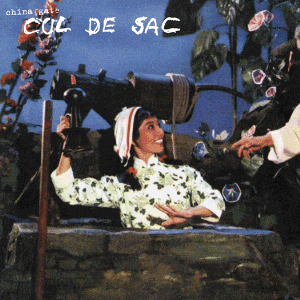
China Gate (1996):
". . . light-footed, joyous, breathless . . . epic and remorselessly romantic . . . the sound of Baudrillard's America blurring past the car window on a heat warped day in the summertime." --Jade Gordon, Melody Maker
"One gets the feeling that a new -- I mean truly new -- genre could be forming before our ears." --Scot Hacker, Utne Reader
". . . psych-eclectic music of rare virtuosity . . . should be the masterwork that nets Cul de Sac the attention they deserve." --Dave Segal, Alternative Press
". . . hint[s] at some other, Alien realm." --Mike Barnes, The Wire
". . . maps out an intricate melange of textures and moods, from dense, hypnotic guitar pieces to the occasional odd, sci-fi sound collage, to near-epic compostions rooted in Middle Eastern melodies. . . ." --Colin Helms, CMJ (Jackpot! Hit)
". . . everything you've heard is true, as the amorphous idea of 'sound' finds itself excercised to maximum effect, all within a stunning context of musical, agile songwriting." --Jason Ferguson, Raygun
"With their third release, Cul de Sac further develop their unique style, a synthesis of sitar, '60s surf, and noisy, synthesizer driven prog-rock . . . relies on diversity and undeniable catchiness to groove out Cul de sac's own niche. . . ." --Walt Reed, Gavin Report
". . . returns to the more variegated hues and bulbous whimsy of the band's debut, ECIM, and allows the listener to hear the formidable scope of the players." --Simon Reynolds, Request
". . . the band casts out its net farther than any of its
peers, referencing jazz and krautrock, surf music and Dr. Who theme music.
The resultant grooves are entrancing and melodic, delivered with the intensity
of white heat." --Julie Taraska, Alternative Press
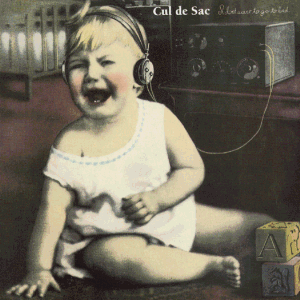
I Don't Want to Go to Bed (1995)
"Like discovering a new universe. . . . Some of the most rhapsodic, unfettered music I've heard in an age. You can take yer Oasises and yer Green Days and shove them up yer shakermaker. Cul de Sac are further proof (as if any more were needed) that there is a bright new future waiting to be born." --Jamie T. Conway, NME
". . . a cauldron of bubling analog synths and guitar atop relentless bass / drums krautrock and tribal rhythms -- improvisation, repetition, propulsion, hallucination . . . instrumental rock for desert sandstorms or tornadoes. . . ." --David Newgarden, CMJ (Jackpot! Pick)
". . . trance rock at its most raw -- seriously trippy
. . . a Faustian pack of noise." --Dave Morrison, Select
ECIM (1992; currently out-of-print, slated for reissue by Strange Attractors Audio House. Copies are still available from us now, but supply is getting low -- see the order page):
". . . phenomenal debut . . . Cul de Sac navigate this realm like enlightened nomads." --Spin
"Soundscapes that inspire a riot for the mind's eye." --Simon Reynolds, N.Y. Times
". . . what a record -- a dazzling delight! . . . a mostly instrumental concoction that fuses blues, country, Pierre Henry-like electronics, Indian ragas and other ethnic influences into something that is even more amazing. . . ." --Alan Freeman, Audion
"Dementia personified. . . . The Can revival has never had so much life in it." --Nick Terry, Lime Lizard
". . . one of the more ambitious, and by far most interesting, records of this young year." --Andy Skibbins, CMJ (Jackpot! Hit)
"Complex industrial music of shorn, stark beauty." --Kevin
Whitlock, Tower Records' Top Magazine
